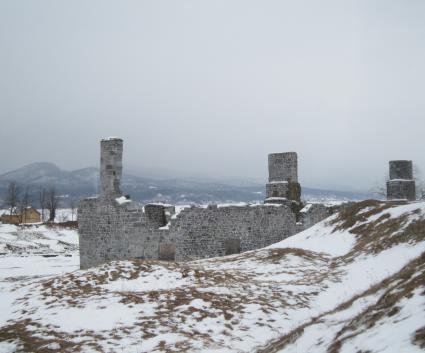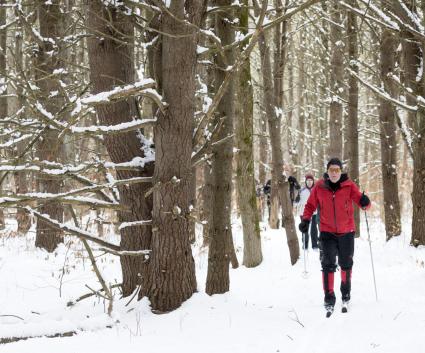I have found a foolproof way to learn history.
I admit it; History was never my best subject. I have trouble remembering all the dates and timelines, which territories belonged in the Holy Roman Empire or what king begat which war.
If I had only BEEN there, I’m sure I could remember it, though. (After all, I remember most everything that I’ve actually lived through.)
On a recent visit to Fort Ticonderoga, that theory was put to the test. I was, indeed, ushered back in time - and without the use of a flux capacitor.*

Party like its 1776
This year (2014 in real life) is actually 1776 at Fort Ticonderoga. Everything and everyone on the property accurately portrays the way that historians understand life to be that particular year at this particular geographic location during the American Revolution.
The friendly attendant at the entrance is the last staff person you’ll meet in contemporary clothing. In 1776, the Fort was held by the Americans, and the staff portrays soldiers of the Fourth Pennsylvania Battalion.
My first stop upon entering the grounds was to take some pictures of the scenic vistas from the perspective of the cannons overlooking Lake Champlain. Who can resist doing that?

Next, I came upon a soldier who was cutting up some meat next to what looked akin to adobe-like holes dug in the ground in a circular pattern. I learned that this was the field kitchen, where the day’s flour and salted pork was being prepared for the soldiers (the officers would typically eat better stuff). The meat was part of a meal that included cabbage, which came from the Garrison Gardens located just outside the Fort.
Fresh vegetables were an important supplement for the soldiers, a way to stave off disease. Cabbage was very important, with high vitamin content and its ability to be stored for winter.
Picture this: “Ticonderoga” represented the entire 2,000-acre property that surrounds the Fort itself. In 1776, the American army at Ticonderoga constituted the third-largest urban concentration of people in North America - there were more than 10,000 people living there. The Garrison Gardens served as the source of food for the whole lot of them.

As I made my way through the tunnel that leads inside the Fort’s parade ground, the Fife & Drum Corps were readying for a performance. While they prepped, I visited the Shoemaker’s Shop.
I was watching the Shoe Maker and his helper work, and some visitors came in and asked questions. It is AMAZING the amount of facts these guys can relate - all without missing a stitch. The Shoe Maker makes handmade shoes for the entire staff every year - averaging about 40 pairs! They will be making shoes of a whole different design during the upcoming winter - shoes appropriate for the Fort’s French inhabitants in 1756.

After marveling at the shoe-making process, I walked over to the Tailor Shop, where there were important repairs being made to an officer’s gaiters. The Tailor is kept quite busy with repairs in general; 1776 was tough on clothing.
18th century clothing is a feature altogether at the Fort this year, but I had to leave the Tailor Shop to learn all about it.

Back to the Future
I marched to the beat of the Fife & Drum Corps right through the door of the Deborah Clarke Mars Education Center at the opposite side of the parade ground, and directly back to 2014.
The Deborah Clarke Mars Education Center hosts special events, seminars and annual special exhibits in the exhibition gallery on the lower level of the building. The gallery serves as a place to highlight rarely-seen items that have been hiding in the museum’s century-old collections. This year (2014), the Fort is featuring an exhibit called “Founding Fashion” in the climate-controlled exhibition gallery.
There are several portraits as well that depict soldiers in uniform - but we now know that those painted in the 19th century are not accurate, as the artists had no samples of actual uniforms to replicate. The exhibit’s centerpiece is four 18th century uniforms that are remarkably preserved, and also includes other garments, accessories such as a knapsack, a huge blanket, and my favorite - an interesting collection of very unique buttons. The individual buttons vary a great deal in design as they were a way to personalize and distinguish one’s clothing. I didn’t take any pictures in the exhibit area since it isn’t allowed - so you’ll have to go see it for yourself!
To the 20th Century and beyond
No visit to the Fort is complete without a visit to the King’s Garden. I left the Founding Fashion exhibit and headed back outside to walk to the Colonial Revival Garden. It is a gorgeous restored formal garden originally designed in 1921. This ornate retreat features a reflecting pool, brick walls and walkways and a stunning display of annuals and perennials. The King’s Garden built for enjoyment is situated adjacent to the Garrison Garden that exists for the soldiers’ sustenance. I strolled past the robust rows of vegetables on my way back to the Fort.

Centuries of Stories
When I returned inside the Fort’s walls, a re-enactor was conducting a musket firing demonstration for a large, rapt audience.
No one needed to hold a gun to my head (not that there was any danger of that) to return again for some of the special events that further tell the many stories that live within and outside the walls of Fort Ticonderoga. There are seemingly endless stories: the restoration, the music, the importance of agriculture, and the people; those that defended the Fort as well as the family that was dedicated to restoring this landmark of such strategic importance in America’s history. Fort Ticonderoga’s story is epic, and it’s the only site in the world that tells a new story every year.
Coming up, events at the Fort include the Garrison Ghost Tour on October 10 and 24, and “Maze by Moonlight” on October 17 & 18. The Heroic Maze corn maze adventure is open through October 19th, and Fort Ticonderoga is open until November 2.
Seasons Past
Don’t despair if you didn’t get to visit in 2014. After all, 1756 is right around the corner!
In the meantime, check out this space-aged 360 panoramic view from the Fort!
*Most of us have seen the popular 1980s “Back to the Future” series in which people can travel through time in a revamped Delorian courtesy of a device called a flux capacitor.
-Kim Rielly is the director of communications for the Regional Office of Sustainable Tourism.











